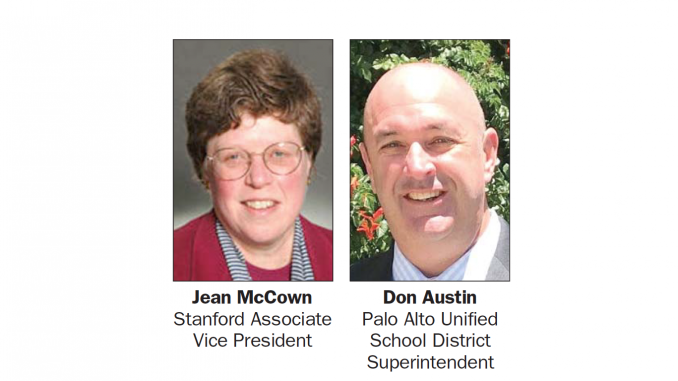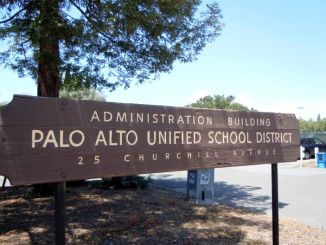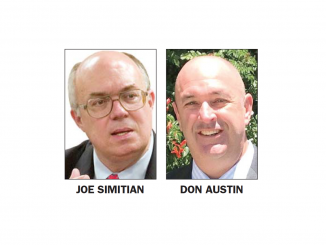
By the Daily Post staff
Talks have stopped between Stanford and the Palo Alto school district over whether the university should build a new school if it’s allowed to expand, school Superintendent Don Austin said yesterday (Dec. 18). But there’s a chance that the district could get what it needs through a development agreement County Supervisor Joe Simitian plans to negotiate with Stanford.
“After several sessions without any proposals from Stanford to mitigate the impact of adding hundreds of students with tax-exempt status in a community-funded school system, it became clear that any mitigation would come through a Development Agreement between Stanford and Santa Clara County,” Superintendent Don Austin told the Post yesterday (Dec. 18).
Stanford Associate Vice President Jean McCown said that the discussions with the district were “preliminary.”
“Preliminary discussions with PAUSD, prior to the start of the development agreement process, began to explore possible approaches to addressing new students generated by additional on-campus faculty and staff housing, and we expect that engagement to continue,” McCown said.
McCown pointed out that Stanford has started discussions with Santa Clara County to create a development agreement. The development agreement is aimed to get additional public benefits outside of what the California Environmental Quality Act requires Stanford provide with the expansion.
The Palo Alto School District is funded chiefly by property taxes. However, academic-related buildings, including housing, are property tax-exempt, meaning that any housing built by the university’s expansion that results in new children going to Palo Alto schools will not pay for itself, unlike current housing in the district. The Menlo Park City School District was faced with a similar issue when Stanford proposed its large mixed-use project at 500 El Camino Real.
“Stanford hopes to continue to engage with PAUSD and other public education stakeholders about the 2018 General Use Permit in order to understand concerns about potential future conditions and to consider how they might be addressed,” McCown said.
Is another school necessary?
However, Stanford officials said in a statement issued on Thursday that if the expansion goes through, the additional faculty and grad students expected to move to campus won’t have enough school-aged children to justify a new school on campus. The consultants who wrote the Final Environmental Impact Report (or FEIR) point out that Palo Alto’s Comprehensive Plan uses a student yield rate of 0.5. The report also claims that the yield rate is 30% higher than the actual student generation rate of 0.38 for existing Stanford faculty/staff housing.
The report sided against the school district’s estimate that for every employee housing unit at Stanford, 0.98 school-aged children will live there.
But as a result of expansions on campus in the past, Stanford has provided land for Palo Alto Schools, including the land for Palo Alto and Gunn high schools. Both Escondido and Nixon elementary schools are on Stanford land.
District has other locations it can use
The consultants who wrote the Final Environmental Impact Report (or FEIR) for the county regarding the expansion, point out that even if school enrollment were to balloon due to the new development, the district already has land it could use — pointing to former schools such as Cubberley, Greendell and Garland in Palo Alto and Pinewood in Los Altos Hills. The report also points out that the district has an agreement with the city to repurchase Ventura if need be.
However, these campuses are all on the other side of El Camino from where Stanford’s new housing will be built.
Whether the school district gets a new campus so new students will not have to walk or bike across El Camino every morning to get to school will be determined by the outcome of the development agreement, which is being negotiated behind closed doors by Stanford officials and County Supervisors Cindy Chavez from San Jose and Simitian from Palo Alto.




So I walk my kid to school across El Camino, finish my principals meeting and volunteering in my kids class (because I don’t get paid enough by stanford to donate to PTA or PiE), then I walk back across El Camino and hike 45+ minutes back to campus so I can sit in my graduate seminar class, host my TA office hours, and then get to the lab to do actual research. Then I hike back to pickup my kid after their school because I can’t enroll them in one of the day care centers that are filled with the kids of the same Stanford admin that decide my kids would be fine in a ’60s era hazmat sischool on the other side of El Camino. Sounds like a plan.
What is your point. Indentured slavery ceased to exist in this country a long time ago. Virtually everything in this post is a clear choice of the author. If this person finds the conditions too onerous, or too unacceptable, then the door is open. This person is free to seek employment, or other situations, as he/she sees fit.
As to all of the “hiking”, ever hear of a bicycle?
Palo Alto High School land was purchased from the District many years ago. If the District were to cease using the land for educational purposes, then it would revert to Stanford.
While it is true that Stanford originally provided land for Palo Alto High, it no longer owns that land. The way this article is written, it would appear that the Post doesn’t understand this.
…then the door is open. This person is free to seek new management, or other situations, as he/she sees fit. Right!